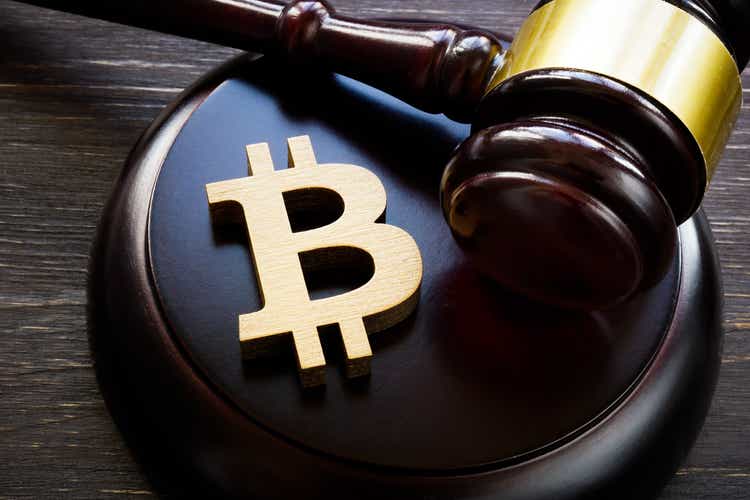Bitcoin (BTC): The battle between HODLers and DCFers

designer491
There have been some significant changes over the years regarding Bitcoin (BTC-USD), with the early adopters primarily considering it to be a store of value, and those later in the game treating it the same way. as a share with high growth in relation to how it should be traded.
In the early years, it was primarily retail investors who took positions in Bitcoin, while in recent years it has been institutional investors and high-net-worth individuals who took large positions in the flagship cryptocurrency.
For years, the price movement of Bitcoin was decoupled from other asset classes, as HODLers refused to sell due to their belief that over time the price of Bitcoin was going to explode into the high 6 figures, and possibly into the 7 figures.
In this article, we’ll look at how it worked in the early years of Bitcoin adoption, and what has changed since when a new type of investor entered the market.
Early adopters of Bitcoin
As mentioned above, early adopters were mostly retail investors who saw Bitcoin as a store of value that would outperform any other asset considered a store of value, including gold.
They would HODL, and still HODL, which when the price of Bitcoin started to shoot up in response to increasing interest, would result in scarcity, reinforcing the upside, which of course was significant when the bulls were in charge.
A question that needs to be asked and answered is, if Bitcoin was a solid store of value, why did the price plummet in apparent response to sellers selling their positions? The answer is that just because there were a significant number of investors HODLing, doesn’t mean there weren’t some happy to take their profits and run.
Another factor was that many people were hit by FOMO, and in response started buying near or at the top, when the price started to reverse direction, they would panic and sell; these were people with more herd mentality than those who actually studied and understood the potential Bitcoin represented. This is different from what is happening today as a result of institutional investors taking positions in Bitcoin, even though the price drop in Bitcoin is the same.
Institutional investors
As those outside of early adopters began to realize that Bitcoin was real, they began to take an interest in the new asset class and invest a significant amount in it.
The one thing they brought to the table, which I think is wrong, is that they lumped Bitcoin in with other technology or high-growth stocks, and consequently when the economy worsened and the Federal Reserve announced that it was going to raise interest rates to fight inflation, institutional investors to sell out.
What happened here is that institutional investors use what is called a DCF model to estimate future profits. At the fundamental level, this means that interest rates will rise, margins and earnings will begin to fall, thus adjusting the outlook for high-growth stocks.
The problem that I see when it comes to using the DCF model is that Bitcoin is being lumped together with high growth stocks as if they are in the same asset. It is my opinion that Bitcoin and cryptocurrencies are an entirely new asset class and must be traded as if they are.
That being said, it doesn’t matter for now. Institutional investors are in control of the price of Bitcoin at this time because of how they treat it, and even if you agree with my assessment, the fact is that for now the price movement of Bitcoin is determined by the big players.
What the fight is about
When I talk about the battle between early adopters and institutional investors, I mean that there are two different ways to look at Bitcoin, and how it will be held and/or traded in the future will be determined by what emerges after the Federal Reserve is done by raising interest rates as a result of inflation falling to the target levels.
Afterwards, as Bitcoin gains further adoption, will new investors who take a position in it consider it a store of value, or will they lump it in with high-growth stocks?
My take on it is that Bitcoin will once again be embraced as a store of value. The reason is demographics. Millennials are the primary investors in Bitcoin, and they are very familiar with it and favorable to its potential as an alternative to the US dollar and gold. Over time, they will dominate the direction Bitcoin takes. That direction will be a store of value, and possibly, depending on the implementation of the Lightning Network, a way to buy goods and services on a daily basis.
The lightning network
For the purpose of this article, I’m not going to do a deep dive into the Lightning Network. As most of my readers know, it is designed to significantly increase the transaction speed of Bitcoin when used to acquire goods and services at the point of sale.
The reason I bring it up here is because there are those in the Bitcoin community who believe that this will be a bigger catalyst than a store of value has been.
Not many investors consider this to be the primary catalyst for Bitcoin, but as the Lightning Network becomes more widely adopted, and some major retailers or service companies begin to increase sales in response to customer preferences, it’s easy to see companies. attempts to include Bitcoin as an alternative to fiat. If and when that happens, the price of Bitcoin could take off to levels even the most ardent bulls could not imagine.
I bring this up to show that there is a third important element in the Bitcoin narrative, but it is not going to be an immediate factor in how investors evaluate Bitcoin in the short term.
Conclusion
The reason why Bitcoin is viewed is important is because different types of investors will hold or trade it based on this determination.
If it is seen as an asset class of its own, it will be seen primarily as a store of value, which will eventually decouple from other asset classes, as it has done in the past, and once again start a new bull run that, in my opinion, will break past highs , almost certainly by a large amount.
As for institutional investors, they will come back again when the economic conditions are favorable, and when they do, they will be a strong catalyst for the decline in the price of Bitcoin.
The difference will be that Bitcoin will disconnect again and float past the high growth stocks the big players will also return to, according to my thesis.
The bottom line is that we need to be careful not to get spooked out of our positions in Bitcoin and regret it for years. Bitcoin is here to stay. It is still in the early years of the growth cycle, as measured by the speed at which the Internet grew when it began to be embraced by the masses, and once the Federal Reserve is done with its rate hikes and inflation falls, I think we will see a Bitcoin bull market that will rise well beyond what we have already seen.
And even if the institutional investors were to maintain control over the price movement of Bitcoin for years, the good news is that investors will still enjoy a large upward movement in price, even if it failed to disconnect from other high-growth assets.
I don’t think that’s how it will go, but when it’s heads you win and tails you win, you just know how big the rewards will be.























